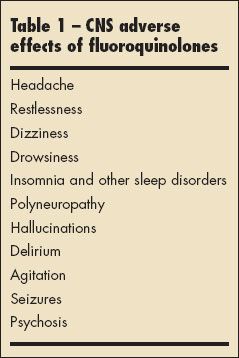- Clinical Technology
- Adult Immunization
- Hepatology
- Pediatric Immunization
- Screening
- Psychiatry
- Allergy
- Women's Health
- Cardiology
- Pediatrics
- Dermatology
- Endocrinology
- Pain Management
- Gastroenterology
- Infectious Disease
- Obesity Medicine
- Rheumatology
- Nephrology
- Neurology
- Pulmonology
Quinolone Neurotoxicity: How to Avoid or Minimize the Risk
Fluoroquinolone antibiotics have activity against a wide range of gram-positive, gramnegative, and atypical bacteria.
Fluoroquinolone antibiotics have activity against a wide range of gram-positive, gram-negative, and atypical bacteria. This class of antibiotics is commonly prescribed for a variety of infections in hospitalized and ambulatory patients. Here we discuss the CNS adverse effects of the fluoroquinolones and ways to reduce the risk of neurotoxicity.
MECHANISM OF NEUROTOXICITY
The development of CNS adverse effects may be attributable to the inhibition of γ-aminobutyric acid (GABA) and N-methyl D-aspartate (NMDA) receptors.1,2 The neurotoxicities reported for fluoroquinolones range from headache to seizure (Table 1). Headache, restlessness, dizziness, and insomnia are some of the most commonly reported (1% to 6%) CNS adverse effects, whereas seizures and psychosis are rare. Rates of CNS toxicities vary slightly depending on the specific fluoroquinolone, but on average they occur at a rate of 0.2% to 2%.1

RISK FACTORS FOR NEUROTOXICITY
The following factors may increase the risk of fluoroquinolone-related neurotoxicity1,2:
- Elderly age.
- Renal insufficiency.
- Underlying CNS disorder.
- Use of other CNS-active medications.
- Drug interactions (NSAIDs, theophylline).
All fluoroquinolones except moxifloxacin require dosage adjustment for renal dysfunction.3 Accumulation of the drug in patients with renal impairment may be a precipitating factor for neurotoxicity.
Underlying CNS disorders are commonly encountered in patients who experience some of the more severe neurotoxicities. Patients with fluoroquinolone-related seizures typically have other risk factors, such as older age, a history of epilepsy, or renal dysfunction. However, one case report demonstrated that seizures may occur in the absence of these conditions.4
Acute psychosis and manic episodes after initiation of a fluoroquinolone have been reported in patients whose underlying psychiatric disorders were well-controlled with antipsychotics. 5,6 Visual and auditory hallucinations, psychosis, and mania have also been reported in patients who do not have a history of psychiatric disorders.2,7-9 Drug interactions that can increase the risk of CNS adverse effects include other CNS-active medications, theophylline, and NSAIDs.1,7,8
HOW TO REDUCE THE RISK OF NEUROTOXICITY
Dose adjustment for renal insufficiency, close monitoring of elderly patients and those with underlying CNS disorders, and minimization of drug interactions are key in preventing CNS adverse effects in patients who receive fluoroquinolones. Cautious prescribing and appropriate follow-up are recommended to decrease the likelihood of fluoroquinolone- induced neurotoxicity.
References:
REFERENCES:
1.
Fish DN. Fluoroquinolone adverse effects and drug interactions.
Pharmacotherapy.
2001;21:253S-272S.
2. Kiangkitiwan B, Doppalapudi A, Fonder M, et al. Levofloxacin-induced delirium with psychotic features. Gen Hosp Psychiatry. 2008;30:381-383.
3. Aronoff GR, Bennett WM, Berns JS, et al. Drug Prescribing in Renal Failure: Dosing Guidelines for Adults and Children. 5th ed. Philadelphia: American College of Physicians; 2007:66-68.
4. Darwish T. Ciprofloxacin-induced seizures in a healthy patient. N Z Med J. 2008;121:104-105.
5. Reeves RR. Exacerbation of psychotic symptoms associated with gatifloxacin. Psychosomatics. 2007; 48:87.
6. Satyanarayana S, Campbell B. Gatifloxacin-induced delirium and psychosis in an elderly demented woman. J Am Geriatr Soc. 2006;54:871.
7. Asensio-Sánchez VM, RodrÃguez-Delgado B, GarcÃa-Herrero E, et al. Visual hallucinations secondary to ciprofloxacin treatment [in Spanish]. Arch Soc Esp Oftalmol. 2007;82:299-301.
8. Segev S, Rehavi M, Rubinstein E. Quinolones, theophylline, and diclofenac interactions with the gamma-aminobutyric acid receptor. Antimicrob Agents Chemother. 1988;32:1624-1626.
9. Bhalerao S, Talsky A, Hansen K, et al. Ciprofloxacin-induced manic episode. Psychosomatics. 2006;47:539-540.
